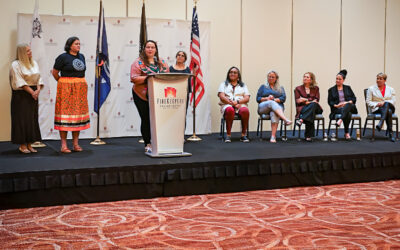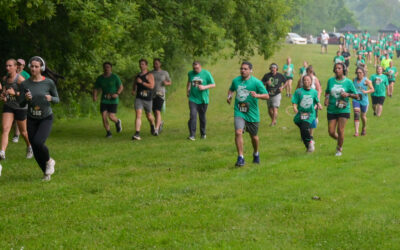FKCH Fire Hub Greenhouse continues growing and innovating
As we enter year three of living with a global pandemic, the FKCH Fire Hub Greenhouse and Community Garden continue to evolve with the expansion of Native American corn production, the introduction of elderberry bushes, improvements to the garden’s fences, construction of four hoop houses, a pavilion and the addition of 25 baby koi fish with their very own water feature.
In Japanese and Chinese culture, the koi fish holds strong symbolism. The fish, a type of carp, is strongly “associated with strength of character, perseverance, accomplishment and courage” and symbolizes “good fortune, success, prosperity and ambition,” according to kraftykoi.co.uk. Koi are hardy and tend to live long lives. We can’t think of a more perfect addition to the Fire Hub’s Greenhouses and Community Gardens’ cast of characters.
“We’re going to see the introduction of the water feature this year. I’ve been growing fish through the winter; koi carp,” Greenhouse Director Stephen Wherry said. “Part of that is to become a relaxing feature for Members to enjoy, but the other part is that I’m going to build an aquaponic system there, on to the water feature, which means we will grow plants from the water used by the fish.”
A new addition to Wherry’s many innovations in the peaceful greenhouse and garden space, the koi pond will serve as more than just a feature at which to marvel and meditate. Innovative and efficient, the water from the koi pond will be used to hydrate and nourish the plants in the greenhouse. The plants will remove and use any additives from the fish, cleaning the water to be recycled back to the koi pond, where the fish will again add nutrients for the plants, perpetuating a cycle of sustainability.
“It’s a very efficient way to grow,” Wherry said, adding that the small-scale project could have greater implications that could benefit Tribal Members. “That could potentially be a project for the Tribe where The Reservation could have its own fish farm, its own fish pond where we grow, on a much larger scale, with fish like tilapia. Then once the fish have finished fertilizing the plants and the plants are grown, we can have a fish harvest for the Members to have regular fresh fish in their diet.”
Standout seed bank
In its third growing season, the greenhouse’s Native American corn crop is coming along splendidly. Wherry was originally gifted a packet of Native American corn seeds at a Food Sovereignty conference in Minnesota in 2020. The first year was “very lucky and successful,” Wherry said.
“The first year was an experimental year which led into the second year, 2021, where we were going to grow enough to produce for a seed bank and enough to create year after year. Within the first two years, we got there very quickly,” he said. “Then I thought it would be a great gift idea if we grow Native American corn and pack it in seed packets so the Tribe can give it to guests or visitors.”
With the success of this endeavor, Wherry sees an opportunity to package the other Sacred Medicines grown at the greenhouses for gifting. Each Séma {Tobacco} plant, for example, yields about 16,000 seeds, Wherry explained, making it ideal for gifting.
Adding to the list of crops, Wherry has introduced elderberry bushes into the mix, eventually hoping to propagate them around the Pine Creek Indian Reservation.
“We are focusing a lot more on Medicines and herbs this year. Nothing new, but we’re going to grow more of it,” Wherry said.
Also continuing this year will be the harvesting of eggs and honey for the Elders’ egg distribution program.
Serene and peaceful space
To make space for these additions, the greenhouse team is adding four hoop houses, a pavilion in the Community Garden complete with picnic tables and benches and a deer-proof fence.
“Last year, we had an incredible issue with deer. We would come to work and shoo eight to 10 deer out of the garden every morning,” Wherry recalled. “They don’t eat all the crops; they take a bit out of one and it’s rendered useless. They’ve contaminated it, so we can’t use it.”
A consistent problem for any gardener, the deer that call The Reservation home will tamper with the Community Garden crops no more. This winter, Wherry and his team built fencing panels and raised beds for the conversion of the Community Garden – which will lose about 30 feet of space to accommodate a pavilion. Though this presents as a challenge, Wherry sees it as an opportunity to elevate the space into an even more welcoming climate and address a drainage issue that has limited plant yields.
“The front end of the garden, because it’s on a slope, would be completely saturated with water due to the snow melt-off each spring. It floods at the front, and it never drains away. I would lose three to four weeks of the start of the season because it was completely saturated,” Wherry explained. “But because we converted to raised beds last year, we’re not going to have that issue, and we can grow the maximum amount of time this year, so that will be good. If the beds do half as well as they did last year, we will be very excited because they were beautiful.”
The pavilion will also offer Tribal Members and NHBP employees an opportunity to work and meet outdoors in a calm and welcoming space. In 2021, Wherry replaced the soil in the raised-bed garden with crushed stone to reduce muddiness. That and the rest of the 2022 improvements – including our new fishy friends – will make for an even more enriching space.
“We’ll see quite a bit of change in the look of the garden this year,” Wherry said. “I think Members are in for a very pleasant experience.”
What’s grown at the greenhouse and Community Garden?
- Séma {Tobacco}
- Tomatoes
- Cucumbers
- Beans
- Peas
- Lettuce
- Squash
- Zucchinis
- Swiss chard
- Rhubarb
- Basil
- Mint
- 3 types of Wabshkekbyag {Sage}
- Peppers
- Pumpkins
- Sunflowers
- Native Corn
- Blueberry
- Strawberry
- Elderberry
- Chives
- Carrots
- A variety of herbs




0 Comments